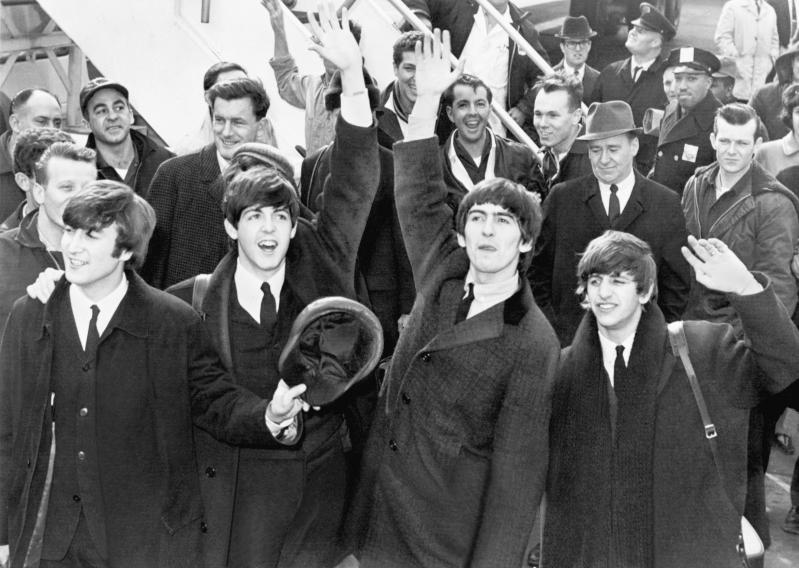The long, cold nights of winter are upon us, and keeping one’s spirits up can be a difficult but essential exercise. Music fans enduring the sleepy South Fork, or for that matter anyone suffering cabin fever, can take heart: A six-dose shot of rhythm and blues will warm cold hearts and shake off the atrophy.
Starting on Sunday, the Montauk Library will host “Twist and Shout: The Beatles on Film,” featuring all five of the Fab Four’s cinematic triumphs — and missteps — plus the director Ron Howard’s loving 2016 tribute to the band’s hundreds of live performances, “The Beatles: Eight Days a Week — The Touring Years.” As the world marks 50 years since the iconic band’s dissolution, the Beatles just keep on giving.
How improbable that John Lennon, Paul McCartney, George Harrison, and Ringo Starr were growing up in the same city, at the same time! Was it coincidence, or karma, that brought together an impossibly, flawlessly complementary creative unit, at the very moment that Elvis and Chuck Berry appeared to illuminate the path, teaching England’s youth how to rock and rebel?
In 1964, rock ’n’ roll and the business of pop music were still new, and “A Hard Day’s Night,” the Beatles’ first and finest film, was United Artists’ effort to cash in on the latest fad with a soundtrack album. But as it happened, “A Hard Day’s Night” is a triumph, a black-and-white vérité mockumentary depicting 36 hours in the life of the Beatles as they run from screaming fans, parry ceaseless, probing media and other demands on their attention, and rehearse and perform on a television program, all in the early springtime of Swinging London.
Directed by an American, Richard Lester, and co-starring Norman Rossington, Victor Spinetti, and Wilfrid Brambell, the film shows the boys bursting with charisma and irreverence, winning over young and old with their fresh, irrepressibly joyous sound. In the 1995 documentary “You Can’t Do That! The Making of ‘A Hard Day’s Night,’ ” the late critic Roger Ebert remembers seeing the film in a theater. “While I was watching that movie, my hair started to grow,” he said. “I’ve seen ‘A Hard Day’s Night’ at least 25 times, and on at least five occasions, I’ve taught it to film classes one shot at a time.”
What a difference a year makes. By the summer of 1965, the Beatles had spawned innumerable imitators across the Western world, recorded and released another LP and several singles, and taken on a creative collaborator. Marijuana, introduced by Bob Dylan in a New York hotel suite in the summer of 1964, quickly altered their consciousness, and with it, their music. “Rubber Soul,” released at the end of 1965, more clearly betrays pot’s influence on the Beatles, but the boys are unmistakably . . . silly in that summer’s silver screen follow-up, “Help!”
The color film is decidedly different from its predecessor, its inane plot involving an Eastern cult that cannot carry out its ritual human sacrifice without a ring that happens to adorn one of Ringo’s fingers. Now mildly euphoric young millionaires, the Beatles’ interest in their second film seems to have focused on exotic locations — scenes in the Austrian Alps and the Bahamas were written into the script — and scoring more marijuana.
“The next one was just bullshit,” Lennon dismissively told Rolling Stone magazine about “Help!”
But the soundtrack! The title track is one of Lennon’s most honest, an insistent but plaintive cry from an inwardly tortured, insecure genius. But he and the boys also rock on “Ticket to Ride” and Mr. McCartney’s “The Night Before” and “Another Girl.” Lennon’s “You’ve Got to Hide Your Love Away” shows the growing influence of Mr. Dylan, and Harrison contributes the charming “I Need You.” “Help!” will be shown on Jan. 5.
Two years after “Help!” the Beatles had created “Sgt. Pepper’s Lonely Hearts Club Band,” their masterpiece and the Summer of Love’s defining document; recorded a new single called “All You Need Is Love” on the first live, international satellite television production, and gone in search of the utopia of universal love as hinted by a new influence, lysergic acid diethylamide, or LSD.
But just as they scaled new and higher heights, their manager, Brian Epstein, died in an apparent accidental overdose. While Epstein’s influence had waned since the Beatles abandoned touring the previous year, the group was momentarily adrift.
The period also coincided both with Lennon’s deep exploration of altered consciousness and the prolific Mr. McCartney’s assertion of leadership. The latter conceived “Magical Mystery Tour” as a play on the English working-class tradition of boozy bus trips to the country or seashore, updated for the 1960s à la Ken Kesey’s Merry Pranksters in sunny California.
The surreal and plotless “Magical Mystery Tour” aired on black-and-white television in Britain on Boxing Day in 1967. Critics were merciless, pouncing on the first crack in the Beatles’ heretofore-impenetrable armor. But all these years later, one can allow that it is of its time, when every artistic medium was open to anything-goes exploration. Think 1968’s “Wonderwall,” for which Harrison composed the score, or “Mord und Totschlag” (“Degree of Murder”), a bizarre 1967 murder story with music by the late Rolling Stone Brian Jones.
And where else can you see the Beatles perform Lennon’s hallucinogenic tour de force, “I Am the Walrus”? That, and gems like Mr. McCartney’s “The Fool on the Hill” and title track are well worth 55 minutes of filmed weirdness. “Magical Mystery Tour” will be screened on Jan. 12.
Though they had little direct involvement, 1968’s “Yellow Submarine” exudes Beatle charm and whimsy, and appeals to our better angels. A perennial children’s favorite, the animated feature pits the Beatles — voiced by actors — against the music-hating Blue Meanies, who invade and drain the color from Pepperland’s kaleidoscopic, surrealistic landscape. The band contributed only four new, and admittedly lesser, songs to the film, but the soundtrack features a wealth of hits from “Pepper” and 1966’s outstanding “Revolver.”
“Yellow Submarine” was an innovation, enormously influential to future animation, including that of Terry Gilliam, a founder of the Monty Python troupe, to which the Beatles would symbolically pass the creative torch in 1969. It will be shown on Jan. 19.
All things must pass, Harrison wrote in the late 1960s — even the Beatles, it turned out. The band returned to vérité for 1970’s “Let It Be,” a document of a band writing its next album while simultaneously breaking up. The intent was noble: strip away the psychedelia and return to live-in-the-studio performance, no overdubs necessary. But the ill-advised decision to assemble at Twickenham Film Studios for 10 a.m. downbeats in London’s frigid January of 1969 is stamped all over the celluloid.
Harrison, who by then had contributed songs rivaling Lennon and McCartney’s finest, was building more than a catalog of great music: Pent-up frustration finally explodes in a caught-on-film confrontation with the band’s overbearing bassist and de facto leader. Lennon, now with his latest collaborator, Yoko Ono, never more than a few feet away, seems to have lost interest.
The project would be shelved and its musical element ultimately completed by Phil Spector. Mr. McCartney was furious. Lennon defended the producer’s work, summarizing the project to Rolling Stone as “the shittiest load of badly recorded shit with a lousy feeling to it ever.”
But halfway through the sessions, the Beatles wisely decamped to their own makeshift Apple Studios, and Harrison’s invitation to the keyboardist Billy Preston to provide a crucial “fifth Beatle” to the live recordings improved the vibe immeasurably. “Let It Be” closes with the band’s surprise daytime gig on their offices’ rooftop, a spirited romp reminiscent of the lunchtime gigs at the Cavern in Liverpool all those years ago.
A word to the wise: The “Let It Be” soundtrack is great, albeit tarnished by Mr. Spector’s inexplicable contributions. Apple Records’ remixed revisit, 2003’s “Let It Be . . . Naked” is both far superior, to this listener, and truer to the original intent. “Let It Be” will be on screen on Jan. 26.
The series concludes on Feb. 9 with Mr. Howard’s award-winning documentary. From the Cavern to Candlestick Park in San Francisco, the site of their last performance (save the impromptu “Let It Be” gig), found footage and digitally restored film bring the Beatles back to life, illustrating with sound and picture the unbridled mania they conjured. With moving reminiscences of concertgoers like Whoopi Goldberg and Sigourney Weaver, contemporary interviews with Mr. McCartney and Mr. Starr, and a large dose of that irrepressible joy, “Eight Days a Week” is an essential addition to the catalog and a suitable ending to an overdue film series.
All films will start at 2:30 p.m. in the Suzanne Koch Gosman Room on the library’s lower level. Admission is free.




